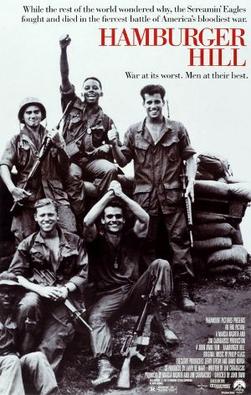Today is the 52nd anniversary of the ending of the Battle of Ap Bia. I had already reviewed the movie "Hamburger Hill", so here is the analysis of the accuracy of the movie.
“Hamburger Hill” has a reputation of being one of the most accurate Vietnam War movies and this is justified, although the movie is not perfect, of course. It chronicles the involvement of a 14-man platoon from B Company, 3rd Battalion, 187th Infantry Regiment, 101st Airborne Division in the Battle of Ap Bia Mountain in the A Shau Valley in S. Vietnam. The battle was part of Operation Apache Snow which was basically a large-scale search and destroy operation to disrupt enemy control of the valley. The most famous action in the operation was the assault on Hill 937 from May 11-20, 1969. The 3/187 was tasked with taking the hill from the south. It was expected to be a few hours of work. This was way off partly because of inadequate intelligence and the belief that the enemy was likely to put up a sharp fight and then retreat. Maj. Gen. Melvin Zais was not expecting a repeat of Dak To where the enemy had put up a sustained fight for days.
Hill 937 refers to the height of the hill, which made it about 3,000 feet above sea level. It was thickly jungled which made fire support difficult. Lt. Col. Weldon Honeycutt, the commander of 3/187, was nicknamed Tiger and had a reputation for aggressive tactics. His call signal was “Blackjack” which is how he is referred to in the movie. The battle did start with a combat assault via helicopters on May 10, but B Company was not landed until May 13 and was originally tasked with taking Hill 916, which it did on May 15 with a minor amount of difficulty. The rest of the battalion began the first of an estimate 11 assaults on May 14. The movie is good at showing the difficulties encountered. The enemy were dug in and used machine guns, grenades, and RPGs (not shown in the movie) to great effect. American artillery and air bombardment were negated by bomb shelters. Rain and the resulting mud made ascension of the steep hill very difficult. To make matters worse, there were five separate friendly fire incidents, four by helicopters. 7 Americans were killed and 53 wounded. The movie does a good job showing one of them.
The first reporters arrived on May 16, but at first they maintained the party line that the battle was going well. However, on May 19, Jay Sharbutt interviewed grunts coming down from the mountain after another failed assault and his report awakened Americans to the true nature of the battle. Sharbutt asked the question why infantry was being used to do what firepower could have accomplished. For instance, B-52s were not used. Most of the soldiers he talked to were disillusioned with the battle and several had harsh things to say about Honeycutt. One of them described the battle as a meat grinder and the name “Hamburger Hill” was coined.
On May 18, Zais planned an attack by 1/506 from the north to coordinate with 3/187 again attacking from the south. Company D almost reached the summit before retreating with every officer either killed or wounded. Zais decided to relieve 3/187 on May 19, but Honeycutt pitched a fit, demanding that his boys be allowed to finish the job. You can imagine how that went over with the men. The next day the final attack was successful. A total of 72 Americans were killed and 372 were wounded. Some companies lost 50-75% of their men, although the 79% of the movie seems a bit high. (And if you count Beletsky, who was wounded and about to be evacuated, but somehow is in at the end, it would be 86%.) But let’s not quibble, the movie does a good job of showing the high casualty rate. However, it should be noted that at Dak To (a battle the soldiers refer to in the movie), the casualties were much worse.
The movie makes a point of criticizing the lack of support for the war from the home front. In some ways the movie is more anti-anti-war than it is anti-war. While the acts of people throwing dog feces on vets has been overblown, there is no doubt that by May, 1969 the American public had soured on the war. In Feb., 1969 only 39% of Americans supported the war and 52% felt it had been a mistake to send troops. The Battle of Ap Bia did not bring those percentages down. It boosted the anti-war movement, especially since the hill was abandoned on June 5. This played into the narrative of “what the hell are we doing over there?” A question both doves and hawks could ask. The reporter in the movie refers to Sen. Edward Kennedy questioning the battle. He actually made the speech on May 20, but close enough. Kennedy called it “senseless and irresponsible… madness”. While the movie does question the frontal tactics, director John Irvin clearly disagrees with Kennedy’s assessment which is evident from his post script proclaiming the battle to have been a victory, but no reference to the biggest takeaway – the hill was not kept. Clausewitz said that if the sacrifices made in a battle do not exceed the value of the outcome, you should not pursue the objective. Hamburger Hill was a classic violation of this principle.

No comments:
Post a Comment
Please fell free to comment. I would love to hear what you think and will respond.